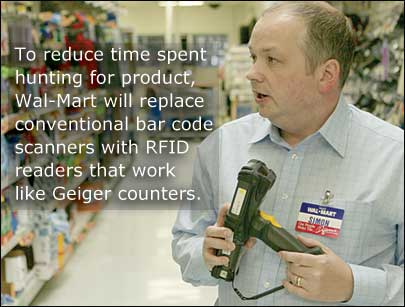By most accounts, Wal-Mart has one of the most efficient supply chains on earth. But even Wal-Mart’s supply chain has inefficiencies. The only way for a store manager to know that some shelves are empty is to have employees (or “associates,” as Wal-Mart calls them) walk the aisles. If an associate spots an empty shelf, he or she scans the bar code on the shelf. A screen on the associate’s handheld bar code scanner indicates how many items are in the store’s back room or in transit to the store.
Often associates spend 15 or 20 minutes looking for items in the back room. If they don’t find them, they sometimes use their handheld computers to change the on-hand inventory to zero and order more cases of the product—even though several cases may be tucked away somewhere.
When the associate orders more products, cases are picked at the nearest distribution center, put on Wal-Mart–owned trucks and sent to the store (deliveries are made daily). When the cases arrive at the store, an associate does not scan them into inventory using a bar code scanner, because that would take too long and slow operations to a crawl. Instead, Wal-Mart assumes that each pallet, case or item ordered has arrived at the store.
“We update perpetual inventory with the quantity shipped to the store, once we receive that trailer,” says Simon Langford, manager of Wal-Mart’s RFID strategy. “But we still don’t know what’s in the back room and what’s gone out to the sales floor and back again. We have no visibility of that.”
These are minor inefficiencies, but they all contribute to product not being on the shelf when the customer wants to buy it, which means Wal-Mart is missing opportunities for sales. The problem becomes compounded during holiday seasons, when many products have a short shelf life. The failure to get goods onto the floor means they have to be marked down after the holiday.
And that’s where RFID comes in. Wal-Mart’s goal is to use the technology to generate automatic “pick lists”—lists of goods that need to be picked in the back room and brought out to the sales floor—and to keep more accurate track of not just the amount of inventory on hand but also its location within the store.
Langford stresses that Wal-Mart is taking a gradual approach. The company doesn’t want to add complexity and make the store associates’ jobs more difficult. The goal is to give associates better information in stages to allow them to adjust to changes in processes and work more efficiently. “We want people to go about the tasks they’re doing normally,” says Langford, “but we want to enhance those tasks and help them work more efficiently—spend less time in the back room and more time on the sales floor.”
Suppliers typically ship tagged cases on pallets to Wal-Mart’s distribution centers in Texas. Wal-Mart breaks down the pallets and ships individual cases to stores. Wal-Mart Supercenters also have a grocery section with a separate receiving area. Goods are typically shipped in full pallets to the grocery section.
The first time tags are read on goods at the store is when they arrive at the receiving bay. On either side of each door at the back of the store, Wal-Mart has installed RFID readers and antennas in metal enclosures. When a shipment arrives, the truck backs up to a door. On the grocery side of the store, Wal-Mart reads all the tagged pallets and as many tagged cases on those pallets as possible. On the mass-merchandise side of the store, staff wheel an accordion-like flexible conveyor up to the back of the truck and take cases off individually, slide them down the conveyor and stack them on pallets in the back room according to product category—toys on one pallet, electronics on another and so on. As each case passes an RFID antenna, a light flashes, indicating that the case’s tag has been read. But there are no computer screens, nothing to slow the unloading of the trucks. The tagged cases are not stacked separately from cases without RFID tags.
Changing business processes
The company is reading 90 percent to 98 percent of singulated cases (those not stacked on a pallet) as they come in to the store and nearly all of the pallets, but only about 60 percent of the cases on pallets (radio waves are unable to penetrate many products to reach the tags on cases in the center of the pallet). Langford says the read rates are high enough to allow Wal-Mart to change business processes and take advantage of the data (for an explanation of how Wal-Mart copes with less-than-perfect read rates, see Not Perfect, But Good Enough).
On-hand inventory is updated, but instead of assuming 10 cases arrived, Wal-Mart now knows 10 cases arrived. The retailer has also installed RFID readers at the doors to the sales floor. When cases or pallets are taken out of the back room and brought to the sales floor to replenish the shelves, the tags on those cases are read. The inventory system in the store has been upgraded to handle RFID data, and the cases are given a temporary status in the system: They are characterized as “being stocked.”
If the readers at the entrance to the sales floor read the case again, Wal-Mart knows the case has been returned to the back room and into inventory, and its status is changed. If a reader installed by the trash compactor reads the tag, Wal-Mart assumes that the items in a case have been put on the shelf. “That’s probably the most critical read point, because that’s the end of the product’s life,” says Langford. “Once we see an EPC at that point, we can make a fair assumption that the product is on the shelf.”
Automated pick lists
Today, only a small percentage of the 62,500 stocking-keeping units in a typical Wal-Mart store or the 116,000 SKUs in a typical Wal-Mart Supercenter arrive with RFID tags. But by placing readers at the three key locations—receiving bays, between the back room and sales floor, and trash compactor—Wal-Mart is able to know where those products are within a store with reasonable certainty.
Wal-Mart is already using that information to generate pick lists automatically for the tagged items. Here’s how it works. Ten tagged cases arrive at the back of the store. Two are brought out to the sales floor. Wal-Mart’s inventory system knows how many items can be stored on the shelf and how many are in a case. So let’s say the shelf can hold 16 items, and each case contains eight. The inventory system knows that the shelf is full.
The retailer’s existing point-of-sale system, which uses bar codes, not RFID, records how many items are sold over the course of a day or week. Each item sold is subtracted from the 16 on the shelf. When, say, 12 items are sold, the inventory system knows there are only four on the shelf, and it triggers an alert for that item to be added to a pick list. “Based on sales history, we can prioritize lists by which items are going to sell out first,” Langford says. “So, instead of getting into a situation where there’s an out-of-stock, we can fill those gaps before we sell out.”
Occasionally, associates indicate through their handheld computer/bar code scanner that they’ve picked an item when they haven’t done so. Without RFID, Wal-Mart has no way of knowing whether an item really has moved from the back room to the sales floor. And this relatively minor issue can be compounded if a manager, thinking the back room has no inventory of that item, orders more from the distribution center. Wal-Mart ends up with too much inventory in the back and a still-empty shelf. With RFID, the only way the inventory system is updated to indicate that a shelf has been replenished with a particular product is if a reader located between the back room and the sales floor reads the tag on a case of that product.
The back room of a Wal-Mart Supercenter is surprisingly small. There isn’t a lot of space for inventory, but associates can still spend upwards of 20 minutes looking for an item on a pick list. To reduce that time, Wal-Mart is introducing a handheld RFID reader that works something like a Geiger counter. An associate can walk down an aisle in the back room, point the reader at stacks of boxes and listen for a beep when the correct case is within the read field. That enables the associate to spend less time in the back room hunting for product and more time with customers on the sales floor. “It’s a big advantage for us,” Langford says. “We can work more effectively. It’s better for our associates, and it’s better for our customers.”
Wal-Mart also plans to introduce alerts for RFID-enabled product. If associates change on-hand inventory to zero and order more of a product from the distribution center, the system will let them know that the product is in the back of the store and should be taken out to the sales floor. “We’ll put in some management tools around that,” says Langford. “But if an associate still sets the on-hand inventory to zero, we know what the unique serial numbers are on the cases, so if we see those cases come out later, we know the decision was wrong. We can correct the on-hand inventory information and add those cases back into the system so we have a more accurate inventory.”
Going forward
Wal-Mart rolled out the new inventory system in mid-January, so it’s still too early to say how much the system is improving on-shelf availability or boosting sales. But Langford says that an in-store test showed that on a busy Saturday night, only one in 12 items that were out of stock was actually replenished in a timely fashion. He believes that RFID-enabled inventory will be able to improve upon that considerably.
The test in that one store also showed that, on average, associates had 30 to 35 cases out on the sales floor at any one time that would be brought back and put away in the back room. Automating the process of creating pick lists and prioritizing the products that should be replaced first will go a long way toward solving this kind of inefficiency.
Wal-Mart’s aim is to install RFID readers in up to 12 distribution centers and 600 stores in the United States by the end of the year. As the retailer rolls out the technology to new geographic regions, it will also deploy whatever new applications and business processes it has developed to those facilities. And it will continue to work in a concentrated cluster of stores to develop new applications and enhance existing inventory management systems with RFID. When the benefits have been proved, those enhancements will be rolled out to the other facilities as well. “It’s still early days,” says Langford. “But the really exciting thing is we’re starting to work more efficiently already.”
Sharing Data with Suppliers
To really reduce out-of-stocks, retailers and suppliers need to work together to better match supply and demand. Even though Wal-Mart is in the early stages of its RFID deployment, it is already sharing information in near-real time with suppliers that are shipping tagged goods to RFID-enabled distribution centers and stores.
Within 30 minutes of a pallet or case tag being read—at the back of the store, between the back of the store and the sales floor, or at the trash compactor—Wal-Mart updates the status of the case or pallet in its Retail Link, an extranet that it has used for years to provide suppliers with point-of-sale transaction data.
Already suppliers are starting to use the visibility data. Today, they depend on average lead times to determine when to replenish. So if it takes, on average, a week to sell 40 cases of detergent and it takes the detergent shipment three days to travel from the factory to the distribution center to the store, the manufacturer can schedule shipments to avoid an out-of-stock. But the average isn’t always right, and if it takes longer for a product to arrive, a store could well experience an out-of-stock.
RFID data lets manufacturers see exactly how long it takes a product to move through the supply chain. Langford says some suppliers have been surprised that products may take a day longer than they expected to move through a certain point, which affects how much product should be replenished and when in order to ensure it’s received just in time and in the right quantity. This information has proved to be so valuable that some suppliers are electing to tag one pallet of a stock-keeping unit that they are not tagging today so they can get the visibility of all their items and see how long they take to move through each point in the supply chain.
The rollout is still just getting started, and Wal-Mart has not collected enough RFID data to enable suppliers to begin to change their replenishment algorithms. But suppliers that have installed RFID readers at their own distribution centers are gaining insights into how their products move through their own supply chain. Over time, the RFID-driven business process changes that Wal-Mart is implementing will be complemented by changes implemented by suppliers, and that’s likely to reduce out-of-stocks—a problem that has plagued retailers and frustrated consumers since forever.




